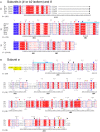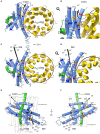ATP Synthase Diseases of Mitochondrial Genetic Origin
- PMID: 29670542
- PMCID: PMC5893901
- DOI: 10.3389/fphys.2018.00329
ATP Synthase Diseases of Mitochondrial Genetic Origin
Abstract
Devastating human neuromuscular disorders have been associated to defects in the ATP synthase. This enzyme is found in the inner mitochondrial membrane and catalyzes the last step in oxidative phosphorylation, which provides aerobic eukaryotes with ATP. With the advent of structures of complete ATP synthases, and the availability of genetically approachable systems such as the yeast Saccharomyces cerevisiae, we can begin to understand these molecular machines and their associated defects at the molecular level. In this review, we describe what is known about the clinical syndromes induced by 58 different mutations found in the mitochondrial genes encoding membrane subunits 8 and a of ATP synthase, and evaluate their functional consequences with respect to recently described cryo-EM structures.
Keywords: F1Fo ATP synthase structure; MT-ATP6; MT-ATP8; mitochondrial DNA (mtDNA); mitochondrial diseases.
Figures




References
Publication types
LinkOut - more resources
Full Text Sources
Other Literature Sources
Molecular Biology Databases

